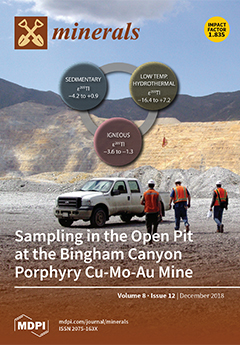The new mineral species carmeltazite, ideally ZrAl
2Ti
4O
11, was discovered in pockets of trapped melt interstitial to, or included in, corundum xenocrysts from the Cretaceous Mt Carmel volcanics of northern Israel, associated with corundum, tistarite, anorthite, osbornite, an
[...] Read more.
The new mineral species carmeltazite, ideally ZrAl
2Ti
4O
11, was discovered in pockets of trapped melt interstitial to, or included in, corundum xenocrysts from the Cretaceous Mt Carmel volcanics of northern Israel, associated with corundum, tistarite, anorthite, osbornite, an unnamed REE (Rare Earth Element) phase, in a Ca-Mg-Al-Si-O glass. In reflected light, carmeltazite is weakly to moderately bireflectant and weakly pleochroic from dark brown to dark green. Internal reflections are absent. Under crossed polars, the mineral is anisotropic, without characteristic rotation tints. Reflectance values for the four COM wavelengths (
Rmin,
Rmax (%) (λ in nm)) are: 21.8, 22.9 (471.1); 21.0, 21.6 (548.3), 19.9, 20.7 (586.6); and 18.5, 19.8 (652.3). Electron microprobe analysis (average of eight spot analyses) gave, on the basis of 11 oxygen atoms per formula unit and assuming all Ti and Sc as trivalent, the chemical formula (Ti
3+3.60Al
1.89Zr
1.04Mg
0.24Si
0.13Sc
0.06Ca
0.05Y
0.02Hf
0.01)
Σ=7.04O
11. The simplified formula is ZrAl
2Ti
4O
11, which requires ZrO
2 24.03, Al
2O
3 19.88, and Ti
2O
3 56.09, totaling 100.00 wt %. The main diffraction lines, corresponding to multiple
hkl indices, are (
d in Å (relative visual intensity)): 5.04 (65), 4.09 (60), 2.961 (100), 2.885 (40), and 2.047 (60). The crystal structure study revealed carmeltazite to be orthorhombic, space group
Pnma, with unit-cell parameters
a = 14.0951 (9),
b = 5.8123 (4),
c = 10.0848 (7) Å,
V = 826.2 (1) Å
3, and Z = 4. The crystal structure was refined to a final
R1 = 0.0216 for 1165 observed reflections with
Fo > 4σ(
Fo). Carmeltazite exhibits a structural arrangement similar to that observed in a defective spinel structure. The name carmeltazite derives from Mt Carmel (“CARMEL”) and from the dominant metals present in the mineral, i.e., Titanium, Aluminum and Zirconium (“TAZ”). The mineral and its name have been approved by the IMA Commission on New Minerals, Nomenclature and Classification (2018-103).
Full article





